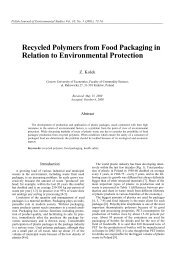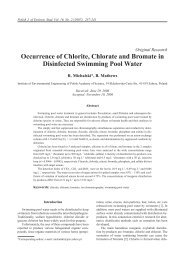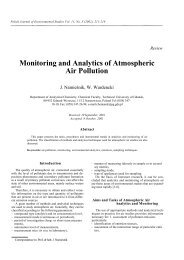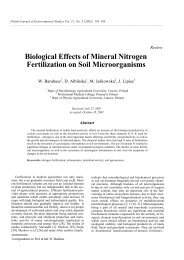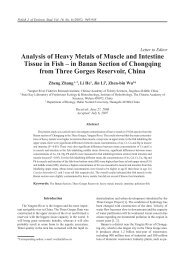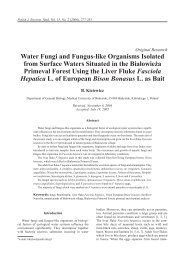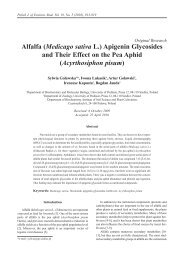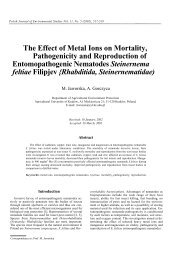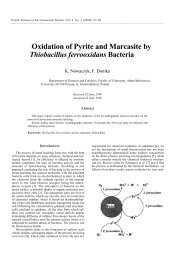Ecological Replacements of Ozone-Depleting Substances
Ecological Replacements of Ozone-Depleting Substances
Ecological Replacements of Ozone-Depleting Substances
Create successful ePaper yourself
Turn your PDF publications into a flip-book with our unique Google optimized e-Paper software.
426<br />
should have a short tropospheric residence time). Additionally<br />
they should have an as low as possible GWP,<br />
suitable thermodynamical properties such a boiling point<br />
or heat vaporisation, relatively short residence time in<br />
the atmosphere, very low acute and subtonic inhalation<br />
toxicity, should not be toxicant or mutagenic [10, 58, 70].<br />
Two classes <strong>of</strong> halocarbons have received particular<br />
attention as replacements for CFC's: hydr<strong>of</strong>luorochlorocarbons<br />
(HCFC's) and hydr<strong>of</strong>luorocarbons (HFC's)<br />
[166]. Like CFC's, they are volatile and insoluble in water<br />
and contain at least one-H atom per molecule. Each molecule<br />
<strong>of</strong> theses classes <strong>of</strong> compounds has an H-C bond<br />
susceptible to attack initiated by OH and OH 2 , the naturally<br />
occurring radicals in the troposphere, thereby<br />
eliminating the compound with its potential to produce<br />
ozone depleting CI atoms before it reaches the stratosphere<br />
[10, 32, 58, 70, 157, 167]. The presence <strong>of</strong> hydrogen<br />
in the molecule makes most <strong>of</strong> them undergo decomposition<br />
in the lower atmosphere. Some <strong>of</strong> the chloromethane<br />
compounds are transported to the stratosphere<br />
and degraded there by reaction with hydroxyl radicals,<br />
free oxygen atoms and by photolysis [97, 99]. As a consequence<br />
they have considerably low or even zero values <strong>of</strong><br />
ODP's. In the case <strong>of</strong> HCFC's, reduction <strong>of</strong> ozone damage<br />
(by 90-95% <strong>of</strong> the original CFC level) is observed,<br />
whereas HFC's (values ODP's = 0) does not affect chlorine<br />
loading. In addition, the above compound groups<br />
show considerably lower values <strong>of</strong> GWP than the CFC's<br />
(compare data given in Table 1 and Table 2) [9, 10, 77].<br />
Although their performance is generally inferior to<br />
that <strong>of</strong> CFC's, various HCFC's and HFC's compounds<br />
are already in use. Of the alternative compounds mentioned<br />
above, the HCFC's in particular are seen only as<br />
transitional substances, whereas the HFC's are long-term<br />
alternatives. In the future, both groups are scheduled for<br />
phase-out by the Montreal Protocol [10, 58, 70]. Additionally,<br />
the production <strong>of</strong> CFC replacements has proven<br />
more complex and more expensive [9].<br />
It was observed that low ozone depletion potential<br />
(ODP) correlates with short tropospheric residence time<br />
(τ), which means that the compound is destroyed in the<br />
troposphere, as mentioned above, before migrating to<br />
the stratosphere [9, 10, 58, 70]. The troposphere residence<br />
time <strong>of</strong> hydrohalocarbons depends upon a number<br />
<strong>of</strong> factors [168, 172]. Amongst them are: the number <strong>of</strong><br />
hydrogen atoms in the molecule, which is particularly important<br />
because the C-H bond is vulnerable to attack by<br />
OH and HO 2 radicals, the number <strong>of</strong> carbon atoms,<br />
number <strong>of</strong> fluorine and chlorine atoms in the molecule<br />
[172].<br />
In 1991 Du Pont began marketing CFC replacements<br />
for refrigeration applications under the trade name<br />
SUVA, CHF 2 Cl (HCFC-22) replaced CC1 2 F 2 (CFC-12) in<br />
industrial, transport and refrigeration units and its<br />
ODP value makes just 5% <strong>of</strong> that <strong>of</strong> CFC-12 [9].<br />
The need to replace CFC's by various halogenoorganic<br />
compounds <strong>of</strong> new generation, characterised by<br />
relatively short residence time, zero or very small CLP<br />
and ODP, acceptable value <strong>of</strong> GWP (HGWP) and no<br />
harmful interaction <strong>of</strong> products <strong>of</strong> their decomposition<br />
on the natural environment has substantially stimulated<br />
development <strong>of</strong> such compounds. A large number <strong>of</strong> producers<br />
has <strong>of</strong>fered a wide range <strong>of</strong> CFC replacements [9,<br />
Wachowski L. et al.<br />
10, 32, 58, 70]. Characterisation <strong>of</strong> the most <strong>of</strong>ten used<br />
replacements is given in Table 2. The best replacement <strong>of</strong><br />
CC1 2 F 2 (CFC-12) was initially the asymmetric tetrafluoroethane<br />
(CF 3 CH 2 F), denoted as CFC-134a or R-<br />
134a [10]. Both DuPont (U.S.) and ICI (U.K.) appear to<br />
be favouring CFC-134a to replace CFC in refrigerators<br />
[9, 58]. One unsolved problem with introducing<br />
CFC- 134a as a refrigerant is that it is incompatible with<br />
the lubricants currently used in refrigerators. Alternative<br />
lubricants are under development, but are not yet available<br />
[9, 58]. The refrigerant CF 3 CH 2 F (CFC-134a) is<br />
more difficult to obtain and is not as efficient as CFC-12,<br />
so recently a better replacement has become R-409A<br />
(see Table 2). The best replacement <strong>of</strong> CFC-11 is trifluorodichloroethane<br />
(CF 3 CHCl 2 ), denoted as CFC-123 or<br />
R-123, but this replacement is less effective because its<br />
molecule contains only two chlorine atoms [99, 100].<br />
The initially proposed replacements <strong>of</strong> CFC's did not<br />
as good thermodynamics properties as CFC's, as manifested<br />
by lower efficiency <strong>of</strong> refrigerators, greater use <strong>of</strong><br />
electric power and louder motors. On top <strong>of</strong> that these<br />
replacements showed significant aggressive effect towards<br />
metals, seals and anticorrosion coatings. A mixture<br />
<strong>of</strong> these compounds with oil, filling the refrigerator motor<br />
at the presence <strong>of</strong> trace amounts <strong>of</strong> water led to corrosion<br />
<strong>of</strong> copper, which was commonly used in construction<br />
<strong>of</strong> small refrigerating units [10, 32, 58]. Consequently,<br />
the industry has been forced to look for and apply new<br />
construction materials [9, 32].<br />
In stationary refrigeration units, such CFC's as CFC-<br />
11 (CCl 3 F), CFC-12 (CC1 2 F 2 ), CFC-113 (CC1 2 FCClF 2 ) and<br />
CFC-114 (CClF 2 CClF 2 ) have been replaced by HCFC-123<br />
(C 2 HCl 2 F 3 ) and HFC-134a (CF 3 CH 2 F) [9, 32, 58, 70]. In a<br />
number <strong>of</strong> domestic, commercial and automotive<br />
applications, HCFC-124a (C 2 HClF 4 ), as well as HCFC-<br />
22 are effective but are not able to maintain a<br />
temperature below -9,5°C. Introducing motors with a<br />
two-stage compression system [9, 99, 159], has solved<br />
this problem.<br />
An examination <strong>of</strong> boiling points suggests the following<br />
compounds as possible replacements for CFC-12<br />
(CCl 2 F 2 ) as a refrigerant: CFC-134a (CF 3 CH 2 F, b.p. -<br />
26°C), CFC-152a (CH 3 CHF 2 , b.p. -25°C), CFC-115<br />
(CF 3 CF 2 Cl, b.p. -38°C), and CFC-22 (CHF 2 C1, b.p. -<br />
41°C). Of these, the fully halogenated compound<br />
CF 3 CF 2 C1 (CFC-115) shows an ozone depleting ability<br />
comparable to that <strong>of</strong> CC1 2 F 2 CF-12. Although CH 3 CHF 2<br />
(CFC-152a) is flammable, it can be used as a "drop in"<br />
replacement for CFC-12. CFC-22 is already in service in<br />
air-conditioners and as a replacement for CFC-11 in<br />
some blown foam [9, 58, 70, 177]. From among the most<br />
<strong>of</strong>ten used replacements <strong>of</strong> refrigerants, HFC-32<br />
(CH 2 F 2 ) is favoured because <strong>of</strong> its lower GWP [9, 10]. As<br />
mentioned above, the physical and chemical properties <strong>of</strong><br />
the replacements proposed proved more or less different<br />
from those <strong>of</strong> CFC's [9,10,58, 70]. An effective approach<br />
to this problem was the use <strong>of</strong> mixtures <strong>of</strong> halocarbon<br />
compounds characterised by greater refrigerating efficiency<br />
and a lower ODP than those <strong>of</strong> individual compounds<br />
[9, 58, 70, 173-175].<br />
For example CFC-12 (Cl 2 F 2 ) is also substituted with a<br />
mixture or less environmentally damaging refrigerant<br />
chlorodifluoroethane (about 15%wt. to about 40%wt.);



